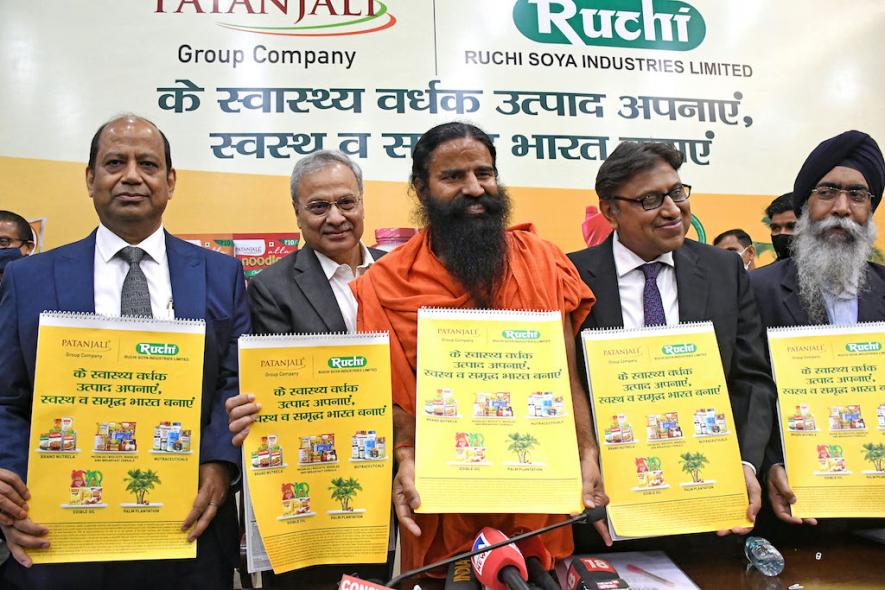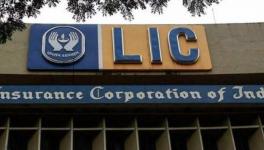Backed by Nationalised Banks, How Ramdev’s Patanjali got Rich Through Ruchi Soya

Baba Ramdev's press conference in Delhi
Bengaluru/New Delhi: On March 28, Ruchi Soya Industries, one of the largest manufacturers of edible oils in India, completed a four-day Follow-on Public Offering (FPO) seeking to raise Rs 4300 crore from the capital markets.
At the time of its closing , the FPO offering was reported to have been subscribed 3.6 times, having garnered bids for 17.56 crore equity shares against the issue size of 4.89 crore equity shares that were on offer. The retail individual investor quota of 35% of the shares was subscribed 0.88 times, i.e, it was under-subscribed by 12%. On the other hand, the qualified institutional buyers portion (of 50% of the shares on offer) was subscribed 2.2 times and the non-institutional investors (describing individuals who invest more that Rs. 2 lakh, but are not registered as institutional investors) portion of 15% of the shares on offer was subscribed 11.75 times.
The company’s Chief Executive Officer, Sanjeev Kumar Asthana, told the media that the company intends to use Rs 3,300 crore of the amount raised to pay off 80-85% of the company’s debt. Once the FPO is completed and the debt paid off, Ruchi Soya’s promoter, Baba Ramdev’s Patanjali Ayurved group of companies is expected to hold a stake of around 81% in the company with a market capitalisation of over Rs 22000 crore. This comes three years after Patanjali acquired Ruchi Soya in 2019 at a price of Rs 4350 crore, after the latter had entered insolvency proceedings under the Insolvency and Bankruptcy Code (IBC).
The process by which Ruchi Soya was acquired by the Yoga guru Baba Ramdev’s business group is an instructive example of nationalised banks, regulatory institutions and tribunals enabling massive wealth accumulation, in this case by Patanjali. Since Patanjali emerged as the highest bidder to acquire the company (after a higher rival bid by Adani Wilmar was withdrawn and bids by Godrej Agrovert and Emami Agrotech were below Patanjali’s bid) in 2019, it has been the beneficiary of financially questionable decisions by a group of nationalised banks, and a light regulatory touch from tribunals, as this article will demonstrate.
How nationalised banks funded Patanjali’s acquisition
Let us consider the sequence of events that led up to Ruchi Soya’s acquisition by Patanjali. When Ruchi Soya went into insolvency proceedings in mid 2017 its debt had risen to Rs. 12146 crore, of which Rs. 9385 crore was owed to banks and financial creditors, most of whom were nationalised banks.
When Patanjali’s bid of Rs. 4350 crore was approved by the Committee of Creditors in 2019 however, some of the same nationalised banks provided loans to Patanjali to finance the bid. It is these loans that the company now says it intends to repay through Ruchi Soya’s FPO.
Outlook Business reported that the State Bank of India (SBI) wrote off Rs. 933 crore of loans to Ruchi Soya that had been classified as non-performing assets, and made a fresh loan of Rs. 1300 crore to Patanjali to help it acquire Ruchi Soya. Punjab National Bank meanwhile wrote off Rs. 346 crore, and made a loan of Rs. 700 crore for the acquisition. Similarly, Union Bank of India wrote off Rs. 149 crore and loaned Rs. 600 crore, Syndicate Bank wrote off Rs. 147 crore and made a loan of Rs. 400 crore, and Bank of Baroda wrote off Rs. 121 crore and made a loan of Rs. 300 crore.
Altogether, the nationalised banks lent around Rs. 3300 crore that financed Patanjali’s Rs. 4,350 crore bid. The same lenders were taking a massive “haircut” on their earlier loans to Ruchi Soya. According to the resolution plan that was approved, banks and financial creditors would receive Rs. 4053 crore against Rs. 9385 crore that Ruchi Soya owed the banks and financial creditors (the remaining part of Patanjali’s bid consisted of Rs. 182 crore repayments to operational creditors and Rs. 115 crore of equity infusion into Ruchi Soya), that implied that the banks were taking a haircut of nearly 57%.
Amazingly, these loans of Rs. 3300 crore were given against a pledge of shares of the same Ruchi Soya that at the time of the acquisition could not be traded on the stock markets and had a consolidated value of Rs. 66 crore (when trading was halted). Surely Ruchi Soya’s assets such as refineries and other facilities around the country, worth far more than the shares, or for that matter the assets of Patanjali, the company that was seeking to acquire Ruchi Soya, could have been pledged instead? Another possibility could have been that banks could have sought to convert Ruchi Soya’s debt into equity.
Even the remaining portion of the acquisition, approximately Rs. 1700 crore, that was to be infused directly by Patanjali into Ruchi Soya was funded through loans by nationalised banks. Outlook Business reports that an 11-bank consortium led by Punjab National Bank provided a Rs. 1700 crore loan as working capital to Patanjali. For this, Patanjali Chairman Acharya Balkrishna “pledged 50% of his shareholding...and the company also hypothecated its entire stock of raw materials, finished and semi-finished goods across its factory premises, godown, transit stores, and book debts that included receivables...and its honey and chawanprash plants...and its units at Sonipat, Newasa and Tezpur.”
Contrast these decisions by nationalised banks in India to another of Ruchi Soya’s creditors – the Singapore based DBS Bank (formerly known as the Development Bank of Singapore). The DBS bank had objected to the resolution plan that was approved by Ruchi Soya’s Committee of Creditors, and approached the National Company Law Tribunal (NCLT). The NCLT however approved the resolution plan over DBS bank’s objections, and subsequent appeals by the DBS bank before the National Company Law Appellate Tribunal (NCLAT), and then before the Supreme Court also failed.
DBS’s objection was that as a secured creditor it would have been able to recoup 90% of its loan exposure to Ruchi Soya if instead of approving Patanjali’s bid, Ruchi Soya’s assets that were pledged to the bank against its loanswere liquidated. However, the NCLAT, and after it, the Supreme Court, did not accept DBS Bank’s arguments, and ignored the applicability of a section of the Insolvency and Bankruptcy Code that required financial creditors who vote against the resolution plan adopted by the Committee of Creditors to get at least the same amount of money that they would have gotten in the event of liquidation of the insolvent company. With its court cases failing, DBS bank was forced to toe the line of the Committee of Creditors led by the SBI, and ended up recovering only 49% of its exposure.
Consider also the creditworthiness of Patanjali at the time when it was given these loans to acquire Ruchi Soya. Outlook Business reported that while the loans were approved in December 2019, just months prior Patanjali’s credit rating had been downgraded by multiple rating agencies. In October 2019, ICRA (formerly known as Investment Information and Credit Rating Agency of India) and CARE (Credit Analysis and Research Limited) downgraded Patanjali from A+ to BBB. ICRA cited “lack of adequate information regarding Patanjali Ayurved Limited’s performance and hence the uncertainty around its credit risk,” and said that despite repeated requests Patanjali’s management had “remained non-cooperative” in providing it with the relevant information. CARE meanwhile “was concerned that the sizable acquisition of Ruchi Soya constituted 151% of Patanjali’s net worth as of March 31, 2019.” Then in November 2019, Brickwork Ratings downgraded a Patanjali group company Patanjali Food and Herbal Park Nagpur to BBB+. The credit rating agency “felt that Patanjali’s debt-funded capital expenditure, including the Ruchi Soya takeover, could adversely impact its gearing and debt-coverage indicators,” and that Patanjali showed a “concentrated shareholding pattern” and a “lack of a diversified board, which comprised the likes of Ram Bharat (Baba Ramdev’s brother) and his wife Sneh Bharat.”
In fact, in October 2019, Union Finance Minister Nirmala Sitharaman remarked that banks need to stop being hesitant in giving loans to self-help groups and companies backed by spiritual leaders which was construed as a remark aimed at Patanjali’s lenders.
Were the banks nudged by vested interests into handing a highly favourable deal to Patanjali at the cost of their investors and depositors, that is the common public? These are questions that there are no clear answers to.
Stock Movements Prior to Ruchi Soya FPO
The other side of this story concerns how Ruchi Soya’s stock has performed since it was re-listed on the Bombay Stock Exchange and the National Stock Exchange after Patanjali’s acquisition.
Between mid November 2019, when the trading of Ruchi Soya’s stocks were halted on the stock exchanges, and January 2020 when the stock was re-listed, Patanjali diluted the existing shares of small investors in Ruchi Soya, raising the share of the company that Patanjali would acquire to 98.9%. In addition to this, in a bizarre manoeuvre, Patanjali managed to drastically increase the value of the company.
On December 19, 2019, when the resolution plan came into effect, 98.9% of Ruchi Soya’s value was extinguished. This meant that the company, which was valued at Rs 66 crores before the halting of trading of shares on November 14, 2019, was valued at Rs 66 lakh on December 20, 2019.
Now came a bizarre twist. A month later, on January 17, 2020, when the company’s new promoters – Patanjali – decided to allocate 18.67 million preferential shares of Ruchi Soya, its share price was decided at Rs 7 (face value of Rs 2 and Rs 5 premium). They reached that figure by taking the 26-week average traded price of Ruchi Soya; it was done despite the halt in trading and the discontinuity in the stock price over that period. This meant that the company that was valued only at Rs 66 lakh on December 20, 2019, was now valued at a whopping Rs 1300 crore.
With Patanjali holding 98.9% of Ruchi Soya’s shares and only 1.1% publicly floated at the time, it was re-listed on the stock markets. Ruchi Soya’s share price has soared in the time since on the back of the very thin public float. From opening at Rs 16.10 per share on January 27 after re-listing, in the past year, it hit a 52-week high of Rs 1377 on June 9, 2021.
The day before the FPO started, Ruchi Soya’s stock price closed at Rs 897.45, and at close of business on March 28, when the FPO closed, it stood at Rs 815.05. This means, since June 9, 2021, the stock has fallen 40.8%.
How justified is this price? According to the company’s filings for the last quarter that ended on December 31, 2021, its book value per share is Rs 148.82. This indicates that the shares were highly overpriced and much higher than the industry and peer-group average. Was this on account of low supply of the shares due to the highly illiquid stock, with a very limited public float?
However, it is on the strength of these stock prices that Ruchi Soya was able to set the price band for its FPO at the level which it did, that is, Rs 615-650. Only once the FPO allocations are completed and the approximately 19% of shares that are being floated arrive in the market will the share’s true value emerge through market mechanisms.
By then, however, on the back of the capital raised, Ruchi Soya will be able to repay the loans Patanjali took to acquire it. In a short period of about two and a half years, the Ramdev-backed Patanjali will have in its hands a company with market capitalisation of over Rs 25,000 crore, on the back of practically no investment of its own, with support from nationalised banks who took on massive losses to facilitate the process. Is this a case of crony capitalism? We leave that to the readers to judge.
A SEBI Order and a Twist in the Tale: The FPO Rebounds
At the time of writing this article, there was another twist in the tale. The subscription of the Ruchi Soya FPO started to fall dramatically after having initially been oversubscribed. This is owing to an order issued by the Securities and Exchange Board of India on Monday, March 28, the last day of the FPO.
The SEBI order says that “unsolicited SMSs advertising the issue, prima-facie the contents of which appear to be misleading/fraudulent” have been circulated regarding the FPO. For this reason, the SEBI order stipulates that a three-day window must be opened, running from March 28 to March 30, during which the bids for share allocations can be withdrawn. The SEBI also instructed that advertisements be placed in newspapers on March 29 and 30 cautioning investors on circulation of unsolicited SMSs and specifying the procedure for withdrawing bids, and that direct SMSs be sent to all the applicants of the received bids informing them of the additional window of withdrawal made available to them.
A report by Moneycontrol notes that “this is not the first time the company has run into trouble with the regulator. In October 2021, the yoga guru and the company were warned by SEBI against dubious investment promises. In a viral video, Baba Ramdev was seen asking his followers to buy shares of Ruchi Soya Industries if they wanted to become crorepatis.”
Although Ruchi Soya issued a statement that the SMSs had not been issued by the company or any of its promoters or directors, this order has resulted in the FPO rebounding. According to Moneycontrol, by 11:15 am on March 29, bids for the retail individual investors quota had reduced to 0.4 times the shares on offer with 1.23 crore bids withdrawn, down from 0.88 on March 28. The qualified institutional investors subscription had reduced to 1.6 times, down from 2.2 times. Overall, the subscription rate for the FPO had fallen to 2.58 times the number of available shares on offer, down from 3.6 times on March 28.
CNBC-TV18 reported that as many as 4.95 crore bids had been withdrawn. Later in the day, the BSE website stopped showing live updated numbers of the FPO, whereas, during the previous four days, it was updating the number of bids received every three minutes. At the time of writing after close of business on March 29, only the close of business figures for March 28 are displayed on the BSE website.
It remains to be seen whether more bids are withdrawn over the three-day withdrawal window, and at what level subscription to the FPO will finally settle.
(The writers are independent journalists.
Get the latest reports & analysis with people's perspective on Protests, movements & deep analytical videos, discussions of the current affairs in your Telegram app. Subscribe to NewsClick's Telegram channel & get Real-Time updates on stories, as they get published on our website.
























